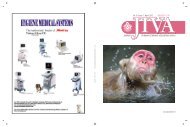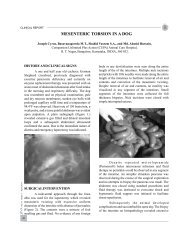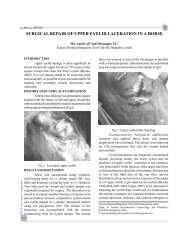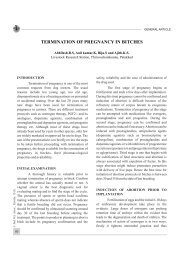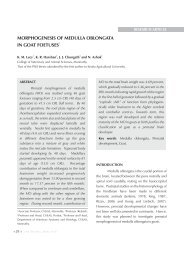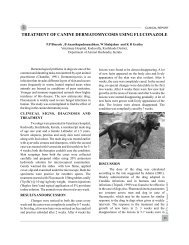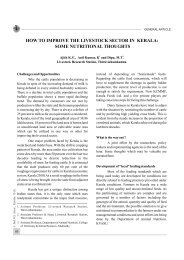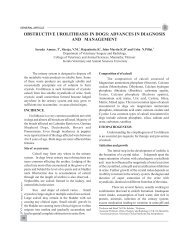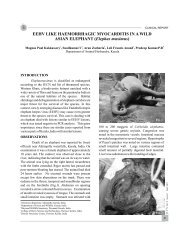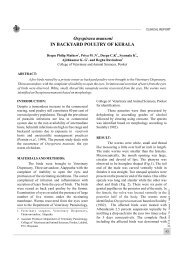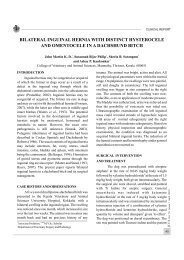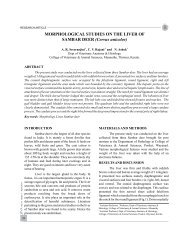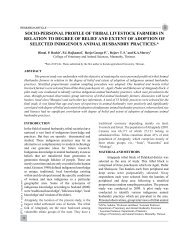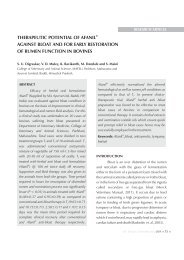management of subcutaneous emphysema in a horse - Jivaonline.net
management of subcutaneous emphysema in a horse - Jivaonline.net
management of subcutaneous emphysema in a horse - Jivaonline.net
You also want an ePaper? Increase the reach of your titles
YUMPU automatically turns print PDFs into web optimized ePapers that Google loves.
CLINICAL REPORT<br />
MANAGEMENT OF SUBCUTANEOUS<br />
EMPHYSEMA IN A HORSE<br />
1 2<br />
Mir Aamir Ali and H.S. Mahesha<br />
Bangalore Turf Club Limited, Racecourse road, Bangalore.<br />
ABSTRACT<br />
A kathiawari <strong>horse</strong> aged three years was<br />
presented with swell<strong>in</strong>g throughout the body.<br />
Cl<strong>in</strong>ical exam<strong>in</strong>ation revealed a pe<strong>net</strong>rat<strong>in</strong>g<br />
wound <strong>in</strong> the axillary region with <strong>subcutaneous</strong><br />
<strong>emphysema</strong>. The wound was closed with<br />
antibiotic impregnated gauze with m<strong>in</strong>imal<br />
debridement an uneventful recovery occurred.<br />
Keywords: Axillary wound, <strong>subcutaneous</strong><br />
<strong>emphysema</strong><br />
the body and also <strong>in</strong>volv<strong>in</strong>g the face. Cl<strong>in</strong>ical<br />
exam<strong>in</strong>ation revealed a pe<strong>net</strong>rated wound <strong>in</strong> the<br />
maxillary region with diffuse accumulation <strong>of</strong> air<br />
with crepitation and the sk<strong>in</strong> pitt<strong>in</strong>g on pressure,<br />
with congested mucus membranes and anorexia<br />
were the other associated symptoms. The wound<br />
was cleaned with normal sal<strong>in</strong>e and the wound<br />
was closed with antibiotic o<strong>in</strong>tment and sterile<br />
guaze. Fig. (1and 2).<br />
INTRODUCTION<br />
Axillary wounds are caused by pe<strong>net</strong>ration<br />
<strong>of</strong> a sharp object like trees, fences, gates and<br />
usually do not <strong>in</strong>volve the thorax (Laverty et.al.,<br />
1996). Marked <strong>subcutaneous</strong> <strong>emphysema</strong><br />
develops because the wound tissue becomes a one<br />
way channel for air and as the <strong>horse</strong> moves the air<br />
progressively accumulates <strong>in</strong> s<strong>of</strong>t tissues. The<br />
trapped air may migrate through fascial planes with<br />
potential to cause pneumothorax, (Hance et.al.,<br />
1992).<br />
CASE HISTORY AND TREATMENT<br />
A kathiawari <strong>horse</strong> aged about 3 years was<br />
presented with a compla<strong>in</strong>t <strong>of</strong> swell<strong>in</strong>g throughout<br />
1 2<br />
Assistant Veter<strong>in</strong>ary Officer, Veter<strong>in</strong>ary <strong>of</strong>ficer, Bangalore Turf<br />
Club Limited, No.52, Racecourse road, Bangalore.<br />
Fig.1. Diffusely swollen head and body<br />
Vol. 10 Issue 3 December 2012 JIVA 59
further accumulation <strong>of</strong> air and cont<strong>in</strong>ued until<br />
recovery. Surgical closure <strong>of</strong> the wound was not<br />
considered as reported by Marble et.al., (1996),<br />
Joellugo (2006) and Florent David et.al., (2008).<br />
Antibiotic impregnated gauze was well tolerated<br />
by the <strong>horse</strong> and follow<strong>in</strong>g which the <strong>horse</strong><br />
recovered without any respiratory complication.<br />
REFERENCES<br />
Fig. 2. Pe<strong>net</strong>rat<strong>in</strong>g wound <strong>in</strong> the axilla<br />
Tetanus toxoid was given <strong>in</strong>itially and<br />
gentamic<strong>in</strong> was given <strong>in</strong>travenous at 6.6mg per Kg<br />
body weight once daily along with metronidazole<br />
at 25mg per Kg orally four times daily and penicill<strong>in</strong><br />
sodium at 22000 I.U. per Kg body weight<br />
<strong>in</strong>travenously twice daily. Phenyl butazone was<br />
given at the dose rate <strong>of</strong> 2.2 mg per Kg<br />
<strong>in</strong>travenously once daily was adm<strong>in</strong>istered for ten<br />
days.<br />
RESULT AND DISCUSSION<br />
The cl<strong>in</strong>ical symptoms as observed <strong>in</strong> the<br />
current case were also reported by Laverty et.al.,<br />
(1996), Hassle (2007). Axillary wounds were found<br />
associated with <strong>subcutaneous</strong> <strong>emphysema</strong> and<br />
predispos<strong>in</strong>g to pneumothorax that was not<br />
observed <strong>in</strong> this case. Stall rest was advised to avoid<br />
Florent David and Sheila Laverty, 2008. Thoracic<br />
Trauma. In:Five m<strong>in</strong>ute Veter<strong>in</strong>ary Consult<br />
Equ<strong>in</strong>e, Jean pierre Lavoie and Ken<strong>net</strong>h<br />
H<strong>in</strong>chcliff (Ed. 2), Elsevier., pp.756-757.<br />
Hance, S.R and Robertson, J.T. 1992. Subcutaneous<br />
Emphysema from an axillary wound that<br />
resulted <strong>in</strong> pneumomediast<strong>in</strong>um and<br />
bilateral pneumothorax <strong>in</strong> a <strong>horse</strong>. J. Am.<br />
Vet. Med. Assoc., 200:pp.1107.<br />
Hassel, D.M. 2007. Thoracic Trauma <strong>in</strong> <strong>horse</strong>s.<br />
Vet. Cl<strong>in</strong>. Equ<strong>in</strong>e., 23:67-80.<br />
Joel Lugo. 2006. Thoracic disorders. In Equ<strong>in</strong>e<br />
Surgery Auer and Stick (Ed. 3), Saunders<br />
Elsevier St. Louis USA., pp. 620-621.<br />
Laverty, S., Lavoie, J. P., Pascoe, J.R and Ducharme,<br />
N. 1996. Pe<strong>net</strong>rat<strong>in</strong>g wounds <strong>of</strong> the thorax<br />
<strong>in</strong> <strong>horse</strong>. Equ<strong>in</strong>e. Vet. J., 28:pp.220.<br />
Marble, S.L., Edens, L.M and Shiroma, J.T. 1996.<br />
Subcutaneous <strong>emphysema</strong> <strong>in</strong> a neonatal<br />
foal. J. Am. Vet. Med. Assoc. 208:pp.97.<br />
BEST SCIENTIFIC PAPER AWARD OF INDIAN VETERINARY ASSOCIATION, KERALA<br />
Indian Veter<strong>in</strong>ary Association, Kerala has decided to give best scientific paper awards annually<br />
for the best papers published <strong>in</strong> Journal <strong>of</strong> Indian Veter<strong>in</strong>ary Association, Kerala from the year 2012.<br />
The awards will be for a best Cl<strong>in</strong>ical paper and a best Research paper. The award consists <strong>of</strong> a citation<br />
and a cash award which will be distributed <strong>in</strong> the Veter<strong>in</strong>arians Annual Convention.<br />
60<br />
J. Ind. Vet. Assoc., Kerala. 10 (3)



